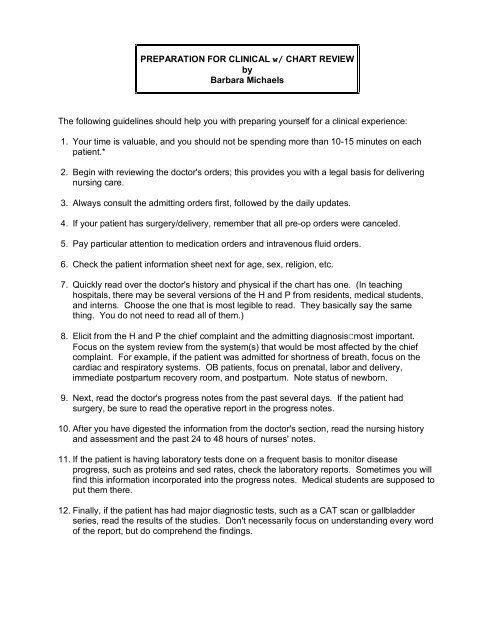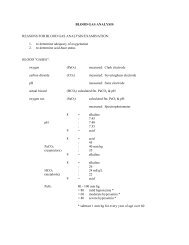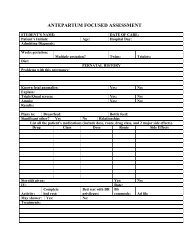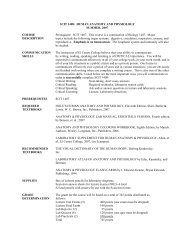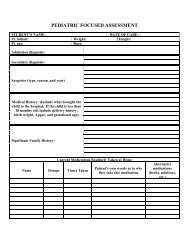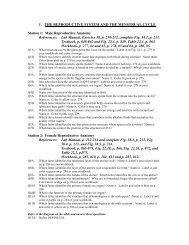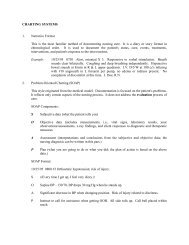PREPARATION FOR CLINICAL w/ CHART REVIEW by Barbara ...
PREPARATION FOR CLINICAL w/ CHART REVIEW by Barbara ...
PREPARATION FOR CLINICAL w/ CHART REVIEW by Barbara ...
Create successful ePaper yourself
Turn your PDF publications into a flip-book with our unique Google optimized e-Paper software.
<strong>PREPARATION</strong> <strong>FOR</strong> <strong>CLINICAL</strong> w/ <strong>CHART</strong> <strong>REVIEW</strong><br />
<strong>by</strong><br />
<strong>Barbara</strong> Michaels<br />
The following guidelines should help you with preparing yourself for a clinical experience:<br />
1. Your time is valuable, and you should not be spending more than 1015 minutes on each<br />
patient.*<br />
2. Begin with reviewing the doctor's orders; this provides you with a legal basis for delivering<br />
nursing care.<br />
3. Always consult the admitting orders first, followed <strong>by</strong> the daily updates.<br />
4. If your patient has surgery/delivery, remember that all preop orders were canceled.<br />
5. Pay particular attention to medication orders and intravenous fluid orders.<br />
6. Check the patient information sheet next for age, sex, religion, etc.<br />
7. Quickly read over the doctor's history and physical if the chart has one. (In teaching<br />
hospitals, there may be several versions of the H and P from residents, medical students,<br />
and interns. Choose the one that is most legible to read. They basically say the same<br />
thing. You do not need to read all of them.)<br />
8. Elicit from the H and P the chief complaint and the admitting diagnosisCmost important.<br />
Focus on the system review from the system(s) that would be most affected <strong>by</strong> the chief<br />
complaint. For example, if the patient was admitted for shortness of breath, focus on the<br />
cardiac and respiratory systems. OB patients, focus on prenatal, labor and delivery,<br />
immediate postpartum recovery room, and postpartum. Note status of newborn.<br />
9. Next, read the doctor's progress notes from the past several days. If the patient had<br />
surgery, be sure to read the operative report in the progress notes.<br />
10. After you have digested the information from the doctor's section, read the nursing history<br />
and assessment and the past 24 to 48 hours of nurses' notes.<br />
11. If the patient is having laboratory tests done on a frequent basis to monitor disease<br />
progress, such as proteins and sed rates, check the laboratory reports. Sometimes you will<br />
find this information incorporated into the progress notes. Medical students are supposed to<br />
put them there.<br />
12. Finally, if the patient has had major diagnostic tests, such as a CAT scan or gallbladder<br />
series, read the results of the studies. Don't necessarily focus on understanding every word<br />
of the report, but do comprehend the findings.
13. If your hospital includes daily medication records in the chart, you will also need to<br />
review them at this time. Make sure that what is ordered in the doctor's orders is<br />
reflected in the medication records.<br />
14. Last but not least, don't be hesitant to ask one of the staff nurses about your patient.<br />
She may confide in you that she hasn't read the chart other than the doctor's orders.<br />
However, she may have attended rounds with the physicians and will be able to give<br />
you insight from that aspect.<br />
15. Don't forget a black pen and your stethoscope.<br />
* These 15 suggestions are intended to help you with efficient use of your valuable<br />
time. There are times, for example, with patients that have been hospitalized for a<br />
long time or have very complicated problems that 15 minutes will not be adequate.<br />
You will have to be the judge of that.<br />
** Don't forget to consult the nursing Kardex also for pertinent information regarding<br />
the care of your patient. But remember, for legal purposes, the information that is in<br />
the chart is what must guide your actions.


